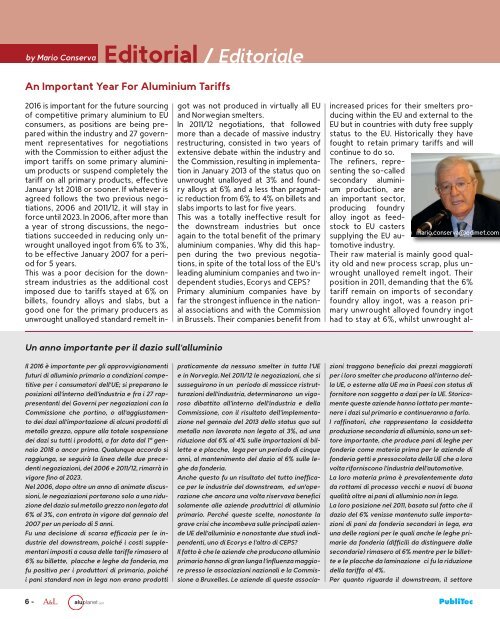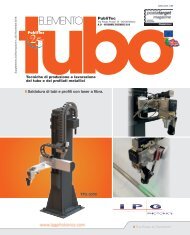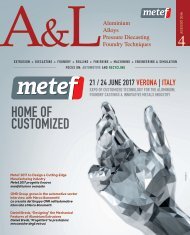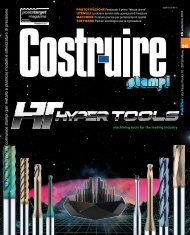A&L_n2_APRILE_2016
Create successful ePaper yourself
Turn your PDF publications into a flip-book with our unique Google optimized e-Paper software.
y Mario Conserva<br />
Editorial / Editoriale<br />
An Important Year For Aluminium Tariffs<br />
<strong>2016</strong> is important for the future sourcing<br />
of competitive primary aluminium to EU<br />
consumers, as positions are being prepared<br />
within the industry and 27 government<br />
representatives for negotiations<br />
with the Commission to either adjust the<br />
import tariffs on some primary aluminium<br />
products or suspend completely the<br />
tariff on all primary products, effective<br />
January1st2018orsooner.Ifwhateveris<br />
agreed follows the two previous negotiations,<br />
2006 and 2011/12, it will stay in<br />
force until 2023. In 2006, after more than<br />
ayearofstrongdiscussions,thenegotiations<br />
succeeded in reducing only unwrought<br />
unalloyed ingot from 6% to 3%,<br />
tobeeffectiveJanuary2007foraperiod<br />
for 5 years.<br />
This was a poor decision for the downstream<br />
industries as the additional cost<br />
imposed due to tariffs stayed at 6% on<br />
billets, foundry alloys and slabs, but a<br />
good one for the primary producers as<br />
unwrought unalloyed standard remelt ingot<br />
was not produced in virtually all EU<br />
and Norwegian smelters.<br />
In 2011/12 negotiations, that followed<br />
more than a decade of massive industry<br />
restructuring, consisted in two years of<br />
extensive debate within the industry and<br />
the Commission, resulting in implementation<br />
in January 2013 of the status quo on<br />
unwrought unalloyed at 3% and foundryalloysat6%andalessthanpragmatic<br />
reduction from 6% to 4% on billets and<br />
slabs imports to last for five years.<br />
This was a totally ineffective result for<br />
the downstream industries but once<br />
again to the total benefit of the primary<br />
aluminium companies. Why did this happen<br />
during the two previous negotiations,<br />
in spite of the total loss of the EU’s<br />
leading aluminium companies and two independent<br />
studies, Ecorys and CEPS?<br />
Primary aluminium companies have by<br />
farthestrongestinfluenceinthenational<br />
associations and with the Commission<br />
in Brussels. Their companies benefit from<br />
increased prices for their smelters producing<br />
within the EU and external to the<br />
EU but in countries with duty free supply<br />
status to the EU. Historically they have<br />
fought to retain primary tariffs and will<br />
continuetodoso.<br />
The refiners, representing<br />
the so-called<br />
secondary aluminium<br />
production, are<br />
an important sector,<br />
producing foundry<br />
alloy ingot as feedstock<br />
to EU casters<br />
mario.conserva@edimet.com<br />
supplying the EU automotive<br />
industry.<br />
Their raw material is mainly good qualityoldandnewprocessscrap,plusunwrought<br />
unalloyed remelt ingot. Their<br />
position in 2011, demanding that the 6%<br />
tariff remain on imports of secondary<br />
foundry alloy ingot, was a reason primaryunwroughtalloyedfoundryingot<br />
hadtostayat6%,whilstunwroughtal-<br />
Un anno importante per il dazio sull’alluminio<br />
Il<strong>2016</strong>èimportantepergliapprovvigionamenti<br />
futuri di alluminio primario a condizioni competitive<br />
per i consumatori dell’UE; si preparano le<br />
posizioni all’interno dell’industria e fra i 27 rappresentanti<br />
dei Governi per negoziazioni con la<br />
Commissione che portino, o all’aggiustamentodeidaziall’importazionedialcuniprodottidi<br />
metallo grezzo, oppure alla totale sospensione<br />
dei dazi su tutti i prodotti, a far data dal 1° gennaio2018oancorprima.Qualunqueaccordosi<br />
raggiunga,seseguiràlalineadelledueprecedenti<br />
negoziazioni, del 2006 e 2011/12, rimarrà in<br />
vigore fino al 2023.<br />
Nel 2006, dopo oltre un anno di animate discussioni,lenegoziazioniportaronosoloaunariduzionedeldaziosulmetallogrezzononlegatodal<br />
6%al3%,conentratainvigoredalgennaiodel<br />
2007 per un periodo di 5 anni.<br />
Fuunadecisionediscarsaefficaciaperleindustrie<br />
del downstream, poiché i costi supplementari<br />
imposti a causa delle tariffe rimasero al<br />
6%subillette, placcheeleghedafonderia,ma<br />
fu positiva per i produttori di primario, poiché<br />
i pani standard non in lega non erano prodotti<br />
praticamente da nessuno smelter in tutta l’UE<br />
e in Norvegia. Nel 2011/12 le negoziazioni, che si<br />
susseguirono in un periodo di massicce ristrutturazioni<br />
dell’industria, determinarono un vigorosodibattitoall’internodell’industriaedella<br />
Commissione, con il risultato dell’implementazione<br />
nel gennaio del 2013 dello status quo sul<br />
metallononlavoratononlegatoal3%,aduna<br />
riduzionedal6%al4%sulleimportazionidibillette<br />
e e placche, lega per un periodo di cinque<br />
anni, al mantenimento del dazio al 6% sulle leghe<br />
da fonderia.<br />
Anche questo fu un risultato del tutto inefficaceperleindustriedeldownstream,<br />
edun’operazione<br />
che ancora una volta riservava benefici<br />
solamentealleaziendeproduttricidialluminio<br />
primario. Perché queste scelte, nonostante la<br />
gravecrisicheincombevasulleprincipaliaziende<br />
UE dell’alluminio e nonostante due studi indipendenti,<br />
uno di Ecorys e l’altro di CEPS?<br />
Ilfattoècheleaziendecheproduconoalluminio<br />
primario hanno di gran lunga l’influenza maggiore<br />
presso le associazioni nazionali e la Commissione<br />
a Bruxelles. Le aziende di queste associazioni<br />
traggono beneficio dai prezzi maggiorati<br />
per i loro smelter che producono all’interno dellaUE,oesterneallaUEmainPaesiconstatusdi<br />
fornitore non soggetto a dazi per la UE. Storicamente<br />
queste aziende hanno lottato per mantenere<br />
i dazi sul primario e continueranno a farlo.<br />
I raffinatori, che rappresentano la cosiddetta<br />
produzione secondaria di alluminio, sono un settoreimportante,cheproducepanidilegheper<br />
fonderie come materia prima per le aziende di<br />
fonderiagettiepressocolatadellaUEchealoro<br />
volta riforniscono l’industria dell’automotive.<br />
La loro materia prima è prevalentemente data<br />
darottamidiprocessovecchienuovidibuona<br />
qualità oltre ai pani di alluminio non in lega.<br />
La loro posizione nel 2011, basata sul fatto che il<br />
dazio del 6% venisse mantenuto sulle importazionidipanidafonderiasecondariinlega,era<br />
una delle ragioni per le quali anche le leghe primariedafonderia(difficilidadistingueredalle<br />
secondarie) rimasero al 6% mentre per le billetteeleplacchedalaminazione<br />
cifulariduzione<br />
della tariffa al 4%.<br />
Per quanto riguarda il downstream, il settore<br />
6-<br />
.com<br />
PubliTec





